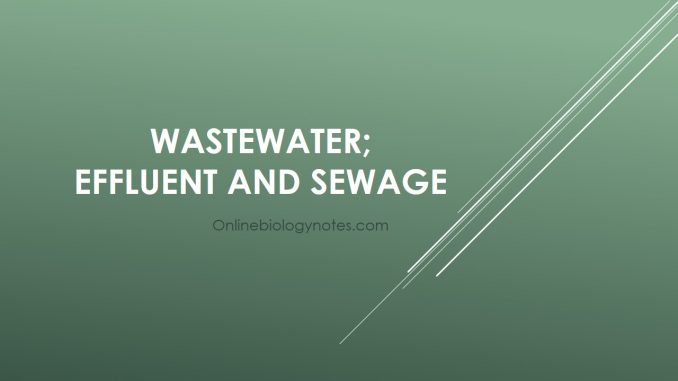
Wastewater
- There are two broad categories of waste water on the basis of their origin. They includes sewage and industrial effluent.
- Sewage is waste water generated from residential areas like community whereas industrial effluent is waste water generated from various industries.
- Domestic sewage and industrial effluent differ in their composition and nature of pollutant. For example, microorganisms and organic matter are main pollutant in sewage whereas various toxic chemicals are main pollutants in industrial effluent.
I. Industrial effluent:
- Waste water generated from various industries is called industrial effluent.
- In general various toxic chemicals alike acid, alkali, coloring agents etc are main pollutants. Microorganisms and organic matters are usually lower in industrial effluent.
- Actual composition and characteristics of industrial effluent depends on type of industry and nature of raw materials of industry.
- Pollutants in industries are generated during processing of raw materials and manufacturing of products.
Some of the common industries and characteristics of their effluents:
1. Leather industry effluent:
- In leather industry raw skin is processed to make leather tough. Steps in making leather from raw skin includes-removal of hairs, liming of skin with Na2S, deliming by NH4Cl or (NH4)2SO4, tanning with chromium and coloring.
- Each steps in skin processing adds pollutants in effluent.
- Some important characteristics of these leather industries effluent are:
- Organic matter; mainly keratin protein, hairs, some fats and coloring dyes
- BOD: 700mg/liter
- Color: strong dark
- Dissolved and suspended solids: high
- pH: 9.5
2. Paper and pulp industry effluent:
- In paper and pulp industries, paper is manufactured from woods.
- Various operations are carried out during paper making such as- preparation of raw materials, pulping, washing, coloring and paper making.
- All of these steps adds some pollutants in effluent.
- Characteristics of these paper industries effluent are:
- Organic matters; mainly cellulose, lignin and coloring agents
- Inorganic matters: acids, alkali, bleaching agents etc
- Color: dark brown
- Suspended solids: 1350mg/ltr
- Dissolved oxygen (DO): 1650mg/ltr
- Effluent is highly resistant to biological oxidation.
3. Dairy industry effluent:
- In dairy industry, various products like cheese, yoghurt, butter etc are produced from raw milk.
- Some of the characteristics of these dairy industry effluent are:
- Organic matter: very high, mainly casein and lactose
- Odor: highly putrescible and bad odorous due to anaerobic decomposition of casein
- BOD: high
- Effluent is highly susceptible for microbial decomposition
- Toxic inorganic matter: very low or absent
4. Distillery and wine industry effluent:
- In distillery and wine industries, carbohydrate is fermented to produce alcoholic products.
- Operations carried out in distillery industries includes- preparation of raw materials, fermentation and down streaming process like distillation of alcohol.
- Pollutants are generated in each steps.
- Some characteristics of these distillery industry effluent are;
- Organic matters: mainly carbohydrates, organic acids, and some spill alcohol
- BOD: high (29000mg/ltr)
- COD: high (80000 mg/ltr)
- Suspended solids:high (4000mg/ltr)
- Color: strong dark
- pH: Acidic
5. Edible oil manufacturing industry effluent:
- In edible oil industry, pollutant are generated during neutralization of excess fatty acids, filtration and distillation of oil.
- Characteristics of these edible oil industry effluent are;
- Organic matter: high content of free and saponified (hydrolyzed) fat
- Suspended solids: high content of suspended and dissolved solids
- BOD: high
- COD: high
6. Detergent industry effluent:
- Detergent industry effluent mainly contains emulsifying agents like phosphorus, borax, alkyl benzene, sulphonate etc
- Effluent is usually alkaline and are non-biodegradable and toxic to aquatic biota.
II. Sewage:
- Wastewater generated from residential area is called sewage.
- Sewage is extremely unpleasant in odor which contains large number of microorganisms, organic matters and other pollutants.
- Pure domestic sewage consists of discharge from bathroom, toilet, kitchen and laboratories. However sometimes industrial effluent are also mixed with sewage.
- Actual composition of sewage depends on type, condition and age of sewage.
- In general sewage contains:
- Sullage: it is waste water generated from kitchen, bathroom, laboratories etc
- Human and animal excreta from toilet and animal farm
- Run-off waste water from street during raining
- Some industrial effluent
